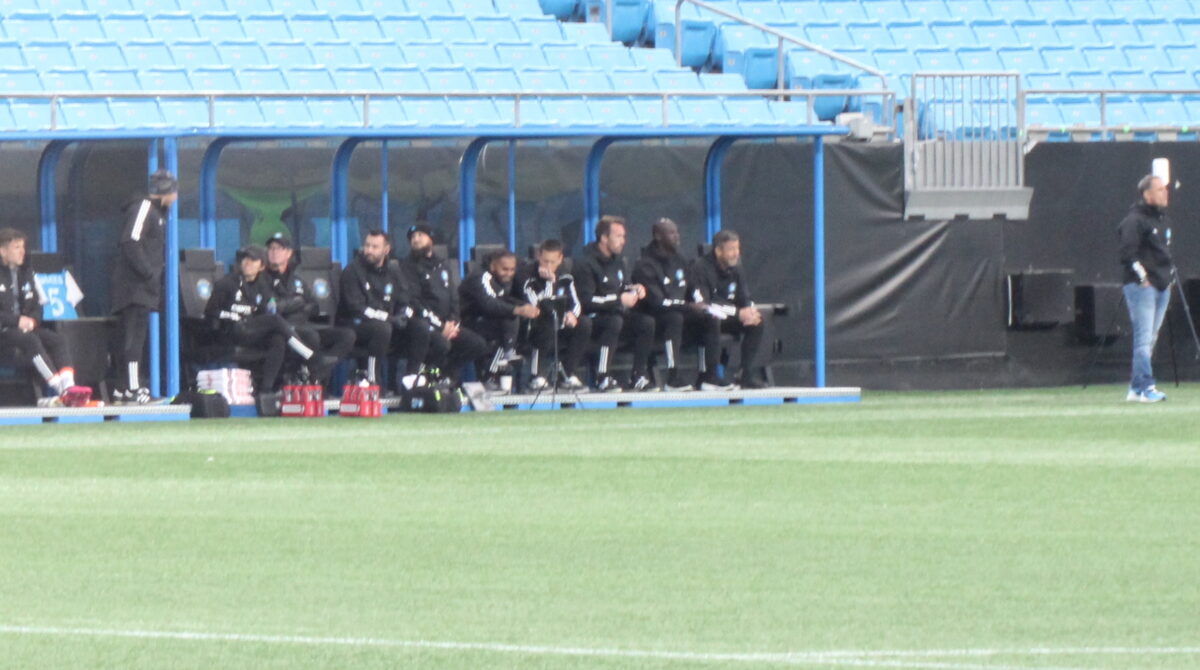Three games into the season, Charlotte FC sit bottom of the Eastern Conference with the worst goal difference in the entirety of MLS. They are one of three teams to be on 0 points and have a worse goal difference than each of the other teams, Houston and Montreal.
It is clear that things have not gone well so far for the 2nd year team, and there was no better example of that than the first half of Saturdays game. Charlotte conceded 3 goals in this half and offered no real structured attack in reply against an impressive Atlanta United team.
Though the fixes for this would not seem simple, the fact is that, at this time, Head Coach Christian Lattanzio is not making things any easier for himself. There are some solutions available to him that we will discuss here, with a particular focus on that first half against Atlanta.
Right now, Charlotte have big questions when it comes to both of the full back spots. Whilst Nathan Byrne playing right back is no surprise, his underwhelming start to the season has raised eyebrows. Meanwhile, Brandt Bronico at left back is something nobody could’ve seen coming, especially after Joseph Mora played a solid game in Charlotte’s opening fixture against New England.
The answer for this decision comes back to one of Lattanzio’s core principles, something we’ve often seen ever since his first game in charge against New York Red Bulls: the inverting of his full backs

In Nathan Byrne and Brandt Bronico, Lattanzio will likely feel that he has his best pairing of players for this role – comfortability on the ball paired with the athleticism to cover the spaces they vacate to invert.
Saturday’s game was the first chance to see each of them perform those roles together, contrasting their debut as a full back pair against St Louis, where importantly they played as fairly traditional full backs.
Against Atlanta, Charlotte displayed probably the most complex build up structure in all of Christian Lattanzio’s time as Head Coach. Though the team still had a 2-4 structure that was seen against St Louis, the way this came together was done very differently.
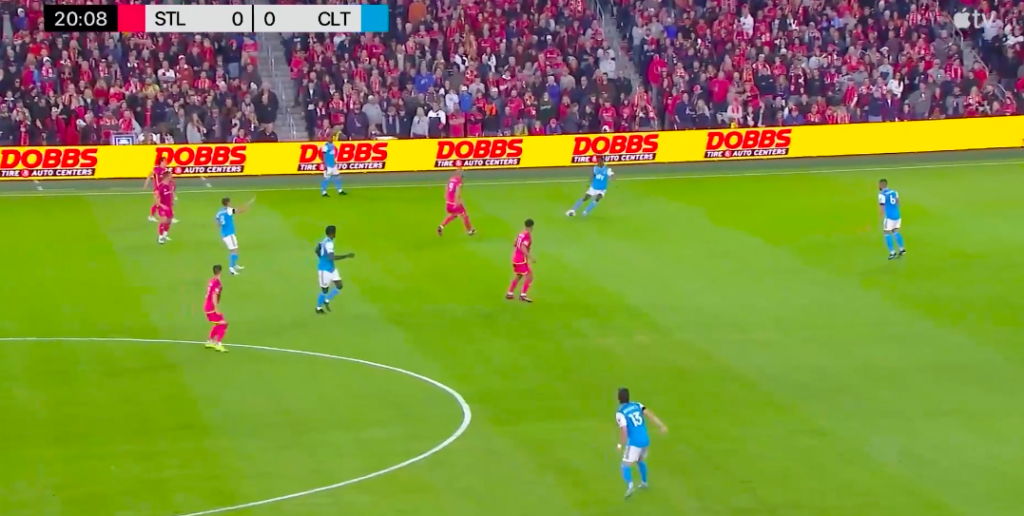
Here we see this setup in the form it would be expected – the centre backs making up the 2 and the full backs pushed up alongside a double pivot to make the 4. Now compare how this setup is constructed to how it was done against Atlanta.
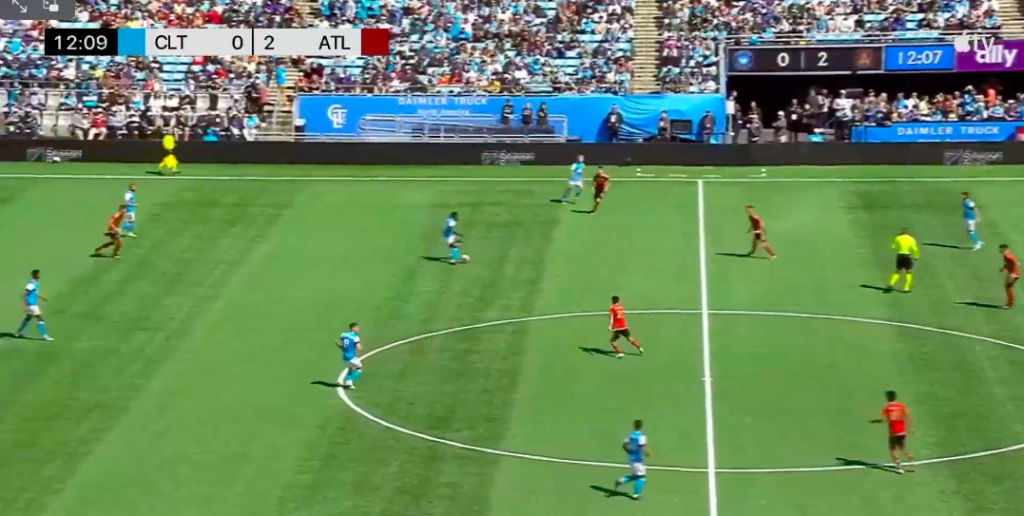
Here, we see a 2-4 structure made up of the same players, except now Jóźwiak has come from his left wing position to play in Bronico’s role, whilst Bronico occupies a more advanced central space as we can see on the end right of the screen.
See also this clip below of how, when the ball moves to the other side of the field, Świderski and Byrne move into these same areas relative to how Jóźwiak and Bronico are structured but on the right side (i.e., Byrne taking up a position higher than Świderski).
It is hard to know exactly why Lattanzio opted for this change, but I suspect that he has 3 core ideas of how he wants his build up to look:
– a base of 2
– a double pivot
– inverted full backs
The ‘inverted full backs’ part of this is obviously the major change from St. Louis to Atlanta, but it is also the part that created problems for Charlotte, especially when it came to their first goal conceded on Saturday.
Though the positioning from Malanda does not help, Charlotte’s rest defense from this structure is still incredibly flawed even with correct established position from the centre backs. The hyper-centrality of this structure is always going to create situations where the opposition will have an extra man over in ‘transition-like’ moments. We saw this right from the beginning of the game.
Again, we see Malanda play way over on the ball-side to squeeze that area, and even with right back in position to help, as Byrne is here, the threat of an unmarked player still exists.
This structure doesn’t just present issues defensively, but also when Charlotte are in attack. With the ball in their possession and the full backs inverted, combined with inverting wingers who want to cut inside, you are left with no real byline threat or predictable attack from wide areas.
Take a situation like this one with Świderski and Byrne:
This would typically be a classic situation where the inverted winger would have a full back overlapping to put the player marking the winger in jeopardy as to whether he should stay with his man or follow the overlapping run. In a situation like that, the decision from the defender would inform what decision the winger on the ball makes.
Instead, in this instance we see that the right back is actually in position to play the ball wide from the central area, then shows for the ball again inside before starting an overlapping run. By this point he is coming from too deep and has waited too long, allowing the defense to re-gain their structure.
Some would call this a failed experiment and revert back to what was done against St Louis. While I do agree that this system can not be a long term solution for Charlotte, I do think that of Lattanzio’s ideals for playing, full back inversion takes quite a high priority given how often we have seen it before in his time as coach.
Instead of completely abandoning the idea of fullback inversion, a compromise must be made elsewhere. I believe it’s time for Charlotte to get to a 3-2 structure in buildup that would help them both in and out of possession.
Firstly, a major benefit of a back 3 build up set up is how much it can help your rest defense. A simple way to explain this would be to ask: why are transition moments so threatening in the first place?
The main benefit of playing in transition is the space that it allows you to play in. In a 2-base structure you can quickly by-pass a cluttered midfield in transition if you win the ball high and directly attack a large amount of space where the defense has only 2 outfield players in between the ball and the goal (rather than 3 if you build up in a 3-2 structure). A simple numbers game to help you defensively is clearly offered by setting up with 3 defenders at the base of your in-possession-structure.
In possession, a 3-2 structure gives you a much better chance to get the ball into advanced wide areas. Having 3 players at the beginning of the structure means all angles into those areas are available, and, with only 2 players ahead, this means that the access into these areas is more direct. Consider how much Charlotte struggled to get the ball to those areas on Saturday, and how easy Austin FC are able to do it here from a base 3 structure
Considering how much investment Charlotte have put into their wide areas, it would be wise to try put them in as best a position as possible. Speaking of which…
A major part of this tactical change has to be the implementation of Karol Świderski back into a central role, and redefining what that central role is.
Putting Świderski back into a central area is a simple first step fix, as we have seen him in the 10 role plenty of times before and know what he brings as the team’s best player. Redefining that role will be much more important.
Take this example from the NYCFC game last season, when Świderski is in the 10 role.
In this setup, Świderski was given a true ‘free role’ to drop deep and facilitate build up, occupying the space in the double pivot to allow one of the original holding midfielder license to get forward. See also how this helps Fuchs, who was playing as an outside centre back in a base 3 in this passage*, get forward into a good position with the ball, link up with Świderski who is still free to relate with other players, then offer a byline threat knowing he has sufficient cover in defense.
*Note: remember, Fuchs is started as a LB in a back 4 base formation this game (4-2-3-1). In this passage of play he is part of a back 3.
Contrast what happens in that above clip with the Charlotte setup now. Currently, we have a hyper-positional setup with no freedom given to Shinyashiki in the 10 role to relate with any of his teammates in build up.
The restriction of Świderski out wide, paired with the restriction of the 10 role itself to whoever plays it, shows the merging of both tactical ideas as a structure and tactical instructions per player. Hyper-positionally in effective systems produces the most elite football we currently have in the game, but at other levels, there must sometimes be a merging of structure around a cerebral talent. This type of talent is what Charlotte have in the Polish international.
In a 3-2 setup, more space would be offered in that 2nd phase of build up for a number 10 to drop in to link the play. The link-up play would be seen both in terms of dropping into wide areas to create triangles and in giving one of the double pivot a chance to get forward by looking to drop in centrally
Using Charlotte’s personnel from that Atlanta game, here is an example of how that 3-2 structure in-possession* could look.
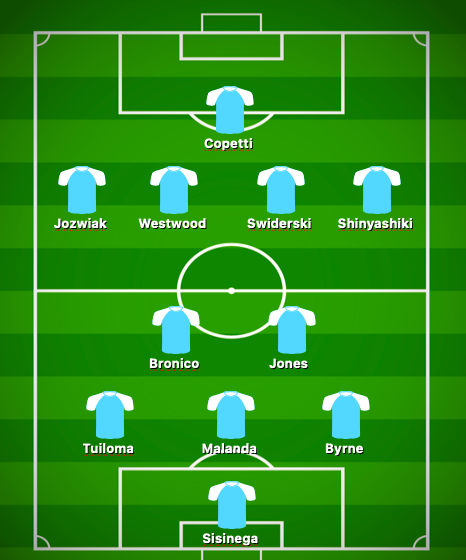
*Note: Again, this is not the starting, base formation. That would still most probably be listed as a 4-2-3-1, as shown below, or 4-3-3. The above is what we would look like in possession.
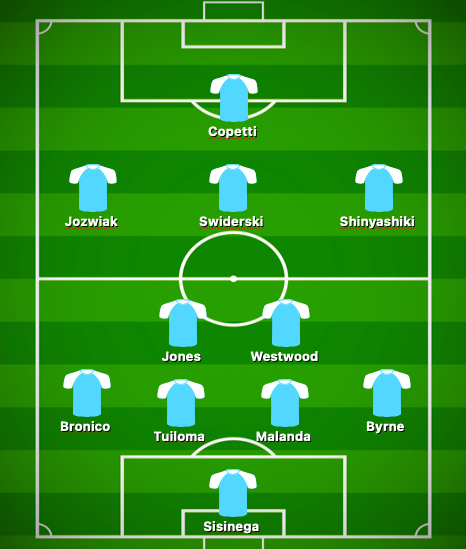
Here in this lineup we have:
– Direct ball access to the wingers.
– Świderski playing centrally with options around him to relate with.
– Sufficient rest defense cover with a base of 3 and 5 good athletes for their roles.
– A box midfield which gives Charlotte the chance to control the game, both in possession and in transition (should we turn the ball over in the opposition third).
This Charlotte team has a lot of talent, and results will likely turn soon anyway as a result of that. But to give the team the best chance long term to have success, this is a switch that should be strongly considered.

